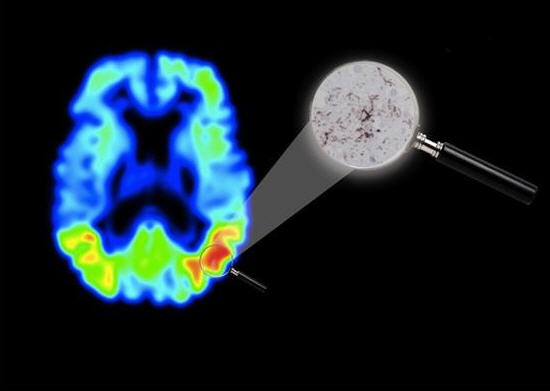New imaging technique in Alzheimer’s disease – opens up possibilities for new drug development

The brain of an Alzheimer’s patient in a tau PET image. Red indicates the areas with the highest concentration of the tau protein. In the magnifying glass, a microscope enlargement showing the dark red streaks and islands of tau. Illustration: Michael Schöll
There are several different methods of producing images showing the changes in the brain associated with Alzheimer’s disease. The tau PET method reveals the presence of a protein in the brain, tau, with the help of a gamma camera and a specially selected radioactive molecule (F-AV-1451).
Tau has an important function in assisting the transport of various substances within the brain’s nerve cells. People with Alzheimer’s disease have raised levels of tau, leading to accumulation of the protein in the brain cells and gradually to cell death.
Lund University and Skåne University Hospital are among other institutions studying patients with the tau PET method for research purposes. Until now, no one has had precise knowledge of how well the new imaging method reproduces the actual changes in a brain affected by Alzheimer’s disease.
The current case study, however, shows that image and reality match up well. The study has enabled researchers to compare tau PET images and brain tissue from the same person for the first time. The brain tissue came from a person who died having recently undergone examination with the new imaging method.
“Tau PET can improve diagnostics, but above all, the imaging method can be of great significance in the development of new drugs to combat Alzheimer’s disease”, explains Ruben Smith, researcher at Lund University and physician at Skåne University Hospital. He continues:
“There are new candidate drugs which aim to reduce the accumulation of tau. The imaging method opens up opportunities to investigate the development of the disease at a detailed level, and to observe how tau aggregates are affected by the drugs.”
“The person who was examined had a mutation which led to the same type of accumulation of tau in the brain as in Alzheimer’s disease. A single case study might seem insignificant, but since there are areas with a lot of tau stored and others with less tau in the same brain, it is sufficient to examine one person in order to verify whether the imaging method works”, explains Oskar Hansson, professor at Lund University and consultant at Skåne University Hospital.
Interest from the research community in imaging methods focusing on tau is strong and growing. A reliable reproduction of tau protein in the brain is considered a more relevant marker and a better diagnostic tool than competing methods which are already in use.
The researchers behind the study are now focusing on tracking aggregation of tau in the brain over time and connections with diagnostics using spinal fluid samples.
Tau PET imaging is considered interesting for other, less common, neurological diseases as well, such as frontal lobe dementia and Parkinson’s-like diagnoses such as PSP (progressive supranuclear palsy) and CBD (corticobasal degeneration).
The results are published in the journal Brain and the study was funded by the European Research Council (ERC), the Swedish Research Council, the Swedish Alzheimer’s Fund and the Swedish Brain Fund, among others.
- Full bibliographic informationEditor’s choice: “18F-AV-1451 tau PET imaging correlates strongly with tau neuropathology in MAPT mutation carriers”, Brain, published online on 29 June 2016. Authors: Ruben Smith, Andreas Puschmann, Michael Schöll, Tomas Ohlsson, John van Swieten, Michael Honer, Elisabet Englund and Oskar Hansson. http://brain.oxfordjournals.org/content/139/9/2372
For further information, please contact:
Cecilia Schubert
0046 (0)730623858
Media Contact
All latest news from the category: Medical Engineering
The development of medical equipment, products and technical procedures is characterized by high research and development costs in a variety of fields related to the study of human medicine.
innovations-report provides informative and stimulating reports and articles on topics ranging from imaging processes, cell and tissue techniques, optical techniques, implants, orthopedic aids, clinical and medical office equipment, dialysis systems and x-ray/radiation monitoring devices to endoscopy, ultrasound, surgical techniques, and dental materials.
Newest articles

Time to Leave Home? Revealed Insights into Brood Care of Cichlids
Shell-dwelling cichlids take intense care of their offspring, which they raise in abandoned snail shells. A team at the Max Planck Institute for Biological Intelligence used 3D-printed snail shells to…

Smart Fabrics: Innovative Comfortable Wearable Tech
Researchers have demonstrated new wearable technologies that both generate electricity from human movement and improve the comfort of the technology for the people wearing them. The work stems from an…

Going Steady—Study Reveals North Atlantic’s Gulf Stream Remains Robust
A study by the University of Bern and the Woods Hole Oceanographic Institution in the USA concludes that the ocean circulation in the North Atlantic, which includes the Gulf Stream,…



